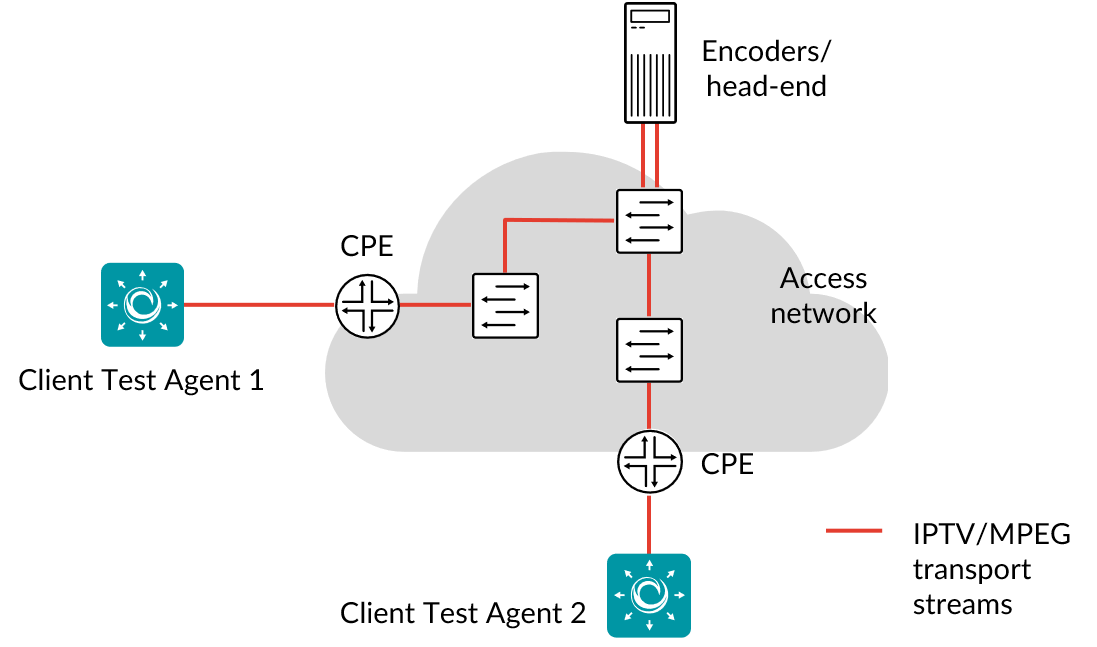IPTV MPEG¶

Test Agents can receive one or several IPTV channels, measuring MPEG TS priority-1 parameters according to ► ETSI TR 101 290 (Measurement guidelines for DVB systems).
The IPTV MPEG task quickly gives you a view of IPTV channel quality at the points where you have connected the Test Agents. Using multiple Test Agents lets you monitor quality in different parts of your network. Routing Active Testing will measure and highlight MPEG loss, PCR jitter, rate, packet loss, continuity count (CC) errors, and any general problems with the MPEG stream.
When an IPTV MPEG task starts, the Test Agents will join the channels by sending IGMP join messages. Once they receive the MPEG streams, the Test Agents will continuously measure quality.
Note
Routing Active Testing does not decrypt any of the MPEG streams; its quality measurements are based on the unencrypted MPEG headers only.
It is possible to configure a threshold for the IPTV PAT/PMT receive interval, that is, define how frequently PAT and PMT information should be detected in the received MPEG stream. Note that this overrides the default frequency of two PAT/PMT packets per second, as specified in ETSI TR 101 290.
This task works with both IPv4 and IPv6.
Prerequisites¶
To run IPTV/MPEG measurements you need to have at least one Test Agent installed. If you haven’t already done the installation, consult the installation guides found here.
Also make sure that you have prepared Routing Active Testing with your IPTV channel list.
Then add an IPTV MPEG task to your test or monitor and fill in the mandatory parameters below:
Parameters¶
See the common parameters page for the following:
Parameters that are set on the test step level: Duration, Fail threshold, and Wait for ready.
SLA thresholds for monitors: SLA Good and SLA Acceptable.
Advanced settings common to all test tasks: Delayed start.
General¶
Clients: Test Agent interfaces on which you want to receive one or several IPTV channels.
Channels: IPTV channels to monitor from the preset IPTV channel list.
See this page. The maximum number of channels that can be monitored is 400.
Thresholds for errored seconds (ES)¶
MPEG loss (CC errors/s): Maximum tolerated MPEG packet loss (CC errors) per second.
See this page. Min: 0 packets per second. Default: 2 packets per second.Jitter: Maximum tolerated PCR and RTP jitter (delay variation) in the received MPEG streams.
See this page. Min: 0 ms. Default: 50 ms.PAT/PMT interval (s): Maximum tolerated interval between PAT/PMT transmissions.
Min: 0.5 s. Max: 60 s. Default: 0.5 s. Note: PAT/PMT should be received every half-second on a program according to the standards.PID interval (s): Maximum tolerated interval between audio or video PIDs as specified by PMT.
Min: 1 s. Max: 60 s. Default: 5 s. Note: On regular audio/video streams, a PID should be received every 5 seconds according to the standards.
Result metrics¶
Rate (Mbit/s): The bit rate of the MPEG program stream.
Transport rate (Mbit/s): The bit rate of the MPEG transport stream (MPEG-TS), that is, the rate of the MPEG stream including the overhead from the header of the Transport Stream packet. See this page for further details.
MPEG loss: MPEG packet loss, calculated from the Continuity_count_error counter in the MPEG stream.
PCR jitter (ms): The jitter (delay variation) of the received MPEG stream. Calculated from the timestamps in the Program Clock Reference (PCR) field transmitted in the adaption layer of the MPEG transport stream.
RTP jitter, RTP loss, RTP misorders: If the MPEG stream contains RTP headers, Routing Active Testing will calculate RTP jitter, loss, and misorderings, which are basically the same as the corresponding metrics for IP. Whether or not the MPEG stream contains RTP headers depends on the encoder at the head-end.
PAT errors: A PAT error is triggered if a Program Allocation Table (PAT) is not received on a multicast group within PAT/PMT interval.
PMT errors: A PMT error is triggered if a Program Map Table (PMT) is not received on a multicast group within PAT/PMT interval.
PID errors: On regular audio/video streams, a frame should be received in every PID interval. If no frame is received within that interval, one PID error is generated for every second that elapses.
ES MPEG loss: Number of errored seconds triggered by MPEG loss exceeding the MPEG loss threshold during one second.
ES jitter: Number of errored seconds triggered by PCR jitter or RTP jitter exceeding the Jitter threshold.
ES invalid stream: An aggregate of PAT, PMT, and PID errors. If any of these types of error is encountered during a second, it is marked as an “Invalid stream” errored second.
ES total: Aggregated errored second percentage, taking into account all types of error.
SLA: Service level agreement fulfillment: equal to (100 – ES total) %.